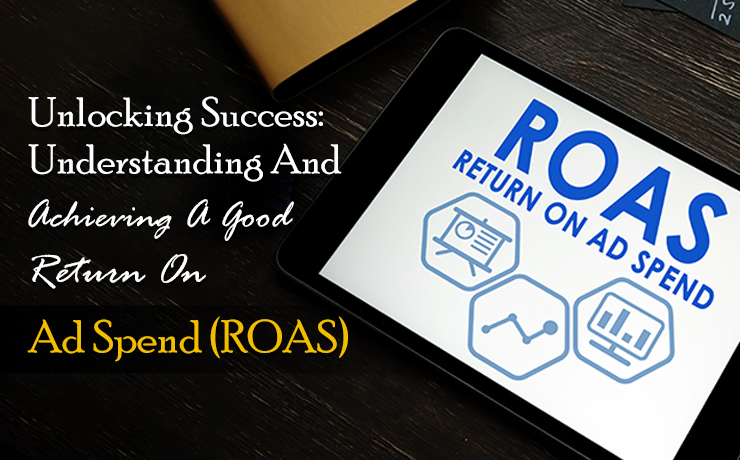Unlocking Success: Understanding And Achieving A Good Return On Ad Spend (ROAS)

Clement Foo
Digital Content Manager

Return On Ad Spend (ROAS) is a crucial metric that measures the effectiveness of your online advertising campaigns. Understanding what constitutes a good ROAS is essential for marketers aiming to optimize their advertising efforts and ensure profitable outcomes.
Deciphering ROAS
ROAS is a metric that calculates the gross revenue generated for every dollar spent on advertising. It is a key performance indicator that helps businesses evaluate which campaigns are driving results and which may need retooling.
The Importance of ROAS
Knowing your ROAS helps in making informed decisions about advertising budgets and strategies, and it serves as a barometer for the financial health of your marketing initiatives.
What Is A Good ROAS?
Determining a good ROAS can vary across different businesses and industries. A common benchmark is a ROAS of 4:1, meaning $4 in revenue for every $1 spent on ads. However, profit margins, operating costs, and other financial considerations can influence the ideal figure.
Industry-Specific Benchmarks
For instance, what is a good ROAS on Amazon may differ from what is a good ROAS for Facebook ads due to differing platform dynamics, competition levels, and customer behaviors.
Factors Influencing ROAS
Several factors can impact your ROAS, including ad creative quality, targeting accuracy, customer lifetime value, and the alignment of the ad with the user’s intent.
The Role of Ad Quality and Targeting
High-quality, compelling ad creatives paired with precise targeting are more likely to engage the right audience and generate a higher ROAS.
Optimizing Campaigns for Improved ROAS
To improve your ROAS, focus on optimizing various elements of your campaigns, from refining ad copy and visuals to enhancing landing pages and the overall user journey.
Continuous Optimization Tactics
Regularly testing and adjusting your campaigns is crucial. This iterative process can lead to gradual improvements in ROAS over time.
Measuring and Analyzing ROAS
Effective measurement and analysis are vital for understanding your ROAS. Utilize analytics tools to track performance data and glean insights that can inform optimization efforts.
Understanding Data-Driven Insights
Leverage the power of data to identify trends and patterns in campaign performance, enabling you to make more strategic advertising decisions.
ROAS in E-Commerce Advertising
In e-commerce, ROAS is particularly important as it directly correlates with direct online sales. This makes it easier to track and attribute revenue to specific ad campaigns.
E-Commerce ROAS Considerations
Consider factors such as cart abandonment rates and average order value when analyzing ROAS for e-commerce. These metrics can provide additional context to the raw ROAS figures.
The Challenge of Achieving a Good ROAS on Amazon
Advertising on Amazon presents unique challenges due to its vast marketplace and competitive nature. Understanding what is a good ROAS on Amazon requires a deep dive into Amazon-specific advertising tactics and consumer behavior.
Leveraging Amazon’s Advertising Tools
Make use of Amazon’s advertising tools and analytics to improve product visibility and track the performance of your ad spend.
ROAS for Social Media Advertising
Social media platforms like Facebook offer advanced targeting options, which can lead to a higher ROAS if leveraged correctly.
What Is A Good ROAS For Facebook Ads?
A good ROAS for Facebook ads depends on factors such as ad placement, audience demographics, and engagement rates. Tailor your strategy to capitalize on Facebook’s robust targeting capabilities.
The Role of Digital Marketing Agencies in ROAS
Digital marketing agencies offer expertise in maximizing ROAS across various advertising platforms. These agencies can provide tailored strategies and insights to enhance campaign performance.
ROAS Optimization
With a focus on data-driven results, SmartSites can assist in fine-tuning your advertising approach to achieve and even exceed your desired ROAS goals.
Long-Term Strategies for Sustaining Good ROAS
Achieving a good ROAS is not just a short-term goal; it requires a long-term strategy that includes nurturing customer relationships, understanding the customer lifecycle, and investing in brand development.
The Bigger Picture
Beyond immediate sales, consider the long-term value of customers and the role of brand recognition in sustaining a healthy ROAS over time.
The Path to ROAS Mastery
Understanding and achieving a good ROAS is a dynamic and ongoing process that demands attention to detail, a willingness to adapt, and a thorough understanding of your audience and platforms. With the right approach, your advertising efforts can yield substantial returns, driving success and growth for your business.









